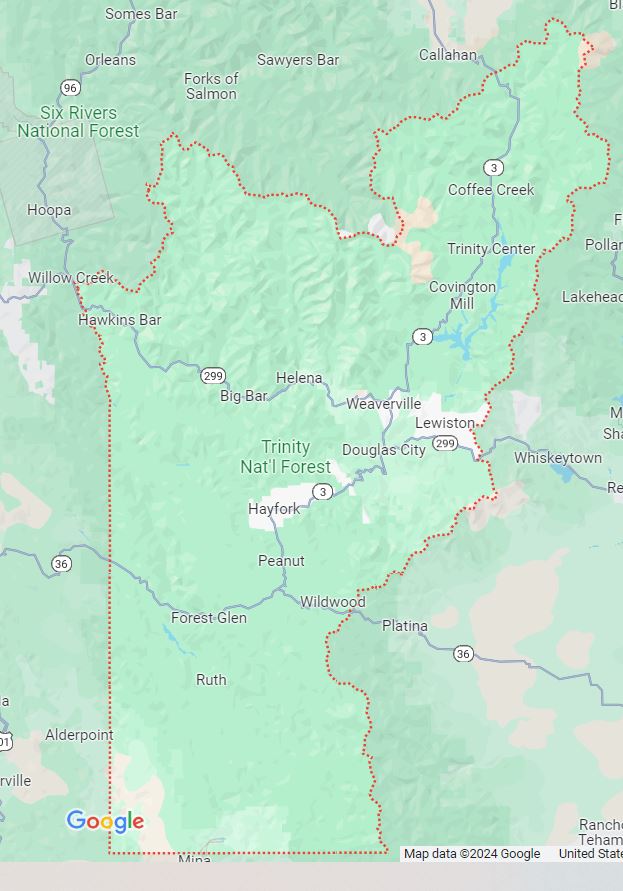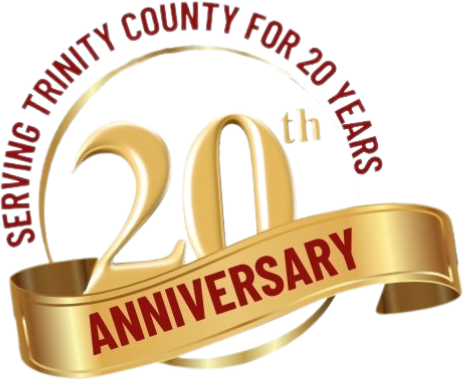ABOUT TRINITY COUNTY

Trinity County, located in the northwestern portion of California, consists of heavily forested terrain along the Trinity River, for which it was named for, within the Salmon and Klamath Mountains. Founded in 1850, Trinity County got its beginnings as a Gold Rush Town and has a rich history of Native Americans Tsnungwe, including the South Fork Hupa, Chimariko and Wintu. With a population of 16,112, as of the 2020 census and the highest elevation of 9,037 ft, it is the 5th least populous county in California and the least populous of the original 27 counties of California. Weaverville, with a population of 3,667, is the largest community within Trinity County and holds the county seat.
Totaling 3,208 square miles, which contain significant portions of the Shasta-Trinity National Forest and the Trinity Alps Wilderness, the second largest wilderness in California. The Trinity Alps consists of hundreds of miles of Forest Service roads, trails and old logging tracts that lead to forested mountains where hiking, horseback riding and mountain biking are popular activities. Wildlife, such as the California Black Bear, deer, mountain lion, coyotes, among others; can be found roaming the hillsides of Trinity County, CA.
Home of the Trinity Lake, the third largest reservoir in California, you can enjoy all types of water activities such as swimming, boating, houseboat rentals, paddleboarding, jet and water skiing and fishing for trout, catfish, small and large mouth bass.
The Trinity River and tributary waters are also sources of adventure and enjoyment offering swimming, fishing, white water rafting and kayaking.
Trinity County enjoys all four seasons and none are extreme. The summers are hot during the day and cool in the evenings. Fall explodes with color throughout the mountains. Winter shows off with some snow but it doesn't stick around too long and Spring gives a beautiful display of flowers.
The county has five general aviation airports, four unified school districts, six elementary school districts and three major highways: State Route 3, State Route 36, and State Route 299. We have public transportation in the form of the Trinity Transit which provides weekly bus services throughout the county and the unemployment rate is currently 6.3%.
Totaling 3,208 square miles, which contain significant portions of the Shasta-Trinity National Forest and the Trinity Alps Wilderness, the second largest wilderness in California. The Trinity Alps consists of hundreds of miles of Forest Service roads, trails and old logging tracts that lead to forested mountains where hiking, horseback riding and mountain biking are popular activities. Wildlife, such as the California Black Bear, deer, mountain lion, coyotes, among others; can be found roaming the hillsides of Trinity County, CA.
Home of the Trinity Lake, the third largest reservoir in California, you can enjoy all types of water activities such as swimming, boating, houseboat rentals, paddleboarding, jet and water skiing and fishing for trout, catfish, small and large mouth bass.
The Trinity River and tributary waters are also sources of adventure and enjoyment offering swimming, fishing, white water rafting and kayaking.
Trinity County enjoys all four seasons and none are extreme. The summers are hot during the day and cool in the evenings. Fall explodes with color throughout the mountains. Winter shows off with some snow but it doesn't stick around too long and Spring gives a beautiful display of flowers.
The county has five general aviation airports, four unified school districts, six elementary school districts and three major highways: State Route 3, State Route 36, and State Route 299. We have public transportation in the form of the Trinity Transit which provides weekly bus services throughout the county and the unemployment rate is currently 6.3%.


